Top Rankings
Auburn-Washburn School District ranks among the top 20% of public school district in Kansas for:
Category
Attribute
Graduation Rate
Highest graduation rate (Top 10%)
Diversity
Most diverse schools (Top 1%)
Community Size
Largest student body (number of students) (Top 1%)
For the 2025 school year, there is 1 public middle school serving 1,008 students in Auburn-Washburn School District. This district's average middle testing ranking is 6/10, which is in the top 50% of public middle schools in Kansas.
Public Middle School in Auburn-Washburn School District have an average math proficiency score of 28% (versus the Kansas public middle school average of 24%), and reading proficiency score of 24% (versus the 28% statewide average).
Minority enrollment is 30% of the student body (majority Hispanic), which is less than the Kansas public middle school average of 35% (majority Hispanic).
Overview
This School District
This State (KS)
# Schools
9 Schools
444 Schools
# Students
5,999 Students
135,097 Students
# Teachers
459 Teachers
9,658 Teachers
Student : Teacher Ratio
13:1
13:1
District Rank
Auburn-Washburn School District, which is ranked within the top 50% of all 286 school districts in Kansas (based off of combined math and reading proficiency testing data) for the 2021-2022 school year.
The school district's graduation rate of 92% has decreased from 94% over five school years.
Overall District Rank
#92 out of 286 school districts
(Top 50%)
(Top 50%)
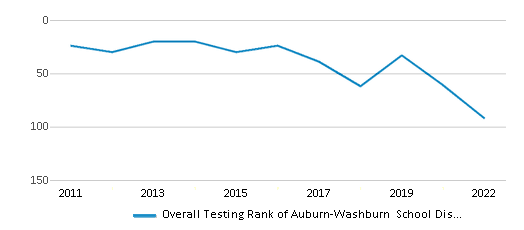
Math Test Scores (% Proficient)
35%
29%

Reading/Language Arts Test Scores (% Proficient)
34%
32%
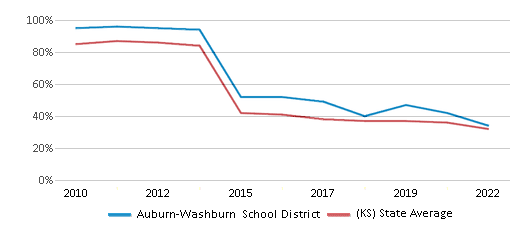
Science Test Scores (% Proficient)
30%
31%
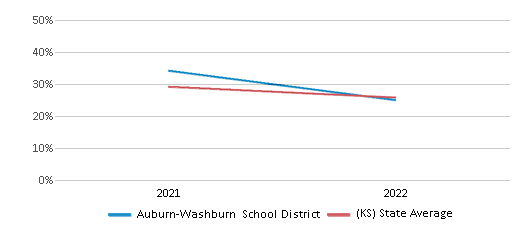
Graduation Rate
92%
89%
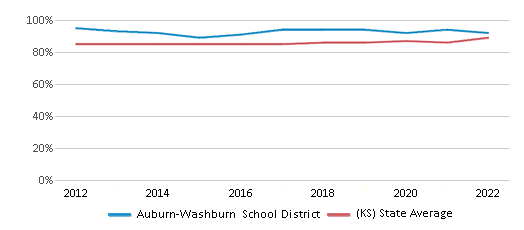
Students by Ethnicity:
Diversity Score
0.48
0.54
# American Indian Students
30 Students
1,123 Students
% American Indian Students
1%
1%
# Asian Students
205 Students
3,384 Students
% Asian Students
3%
2%
# Hispanic Students
637 Students
26,977 Students
% Hispanic Students
11%
20%
# Black Students
306 Students
7,995 Students
% Black Students
5%
6%
# White Students
4,261 Students
87,589 Students
% White Students
71%
65%
# Hawaiian Students
5 Students
288 Students
% Hawaiian Students
n/a
n/a
# Two or more races Students
555 Students
7,741 Students
% of Two or more races Students
9%
6%
Students by Grade:
# Students in PK Grade:
198
1,187
# Students in K Grade:
362
1,373
# Students in 1st Grade:
371
1,723
# Students in 2nd Grade:
430
1,821
# Students in 3rd Grade:
392
1,853
# Students in 4th Grade:
449
2,318
# Students in 5th Grade:
454
3,889
# Students in 6th Grade:
450
26,331
# Students in 7th Grade:
530
35,096
# Students in 8th Grade:
478
36,357
# Students in 9th Grade:
502
5,226
# Students in 10th Grade:
468
5,637
# Students in 11th Grade:
460
5,522
# Students in 12th Grade:
441
5,409
# Ungraded Students:
14
1,355
District Revenue and Spending
The revenue/student of $13,669 in this school district is less than the state median of $16,276. The school district revenue/student has stayed relatively flat over four school years.
The school district's spending/student of $12,979 is less than the state median of $17,192. The school district spending/student has stayed relatively flat over four school years.
Total Revenue
$82 MM
$7,774 MM
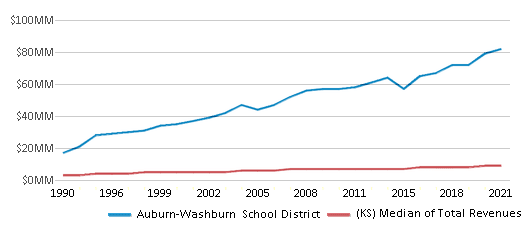
Spending
$78 MM
$8,211 MM
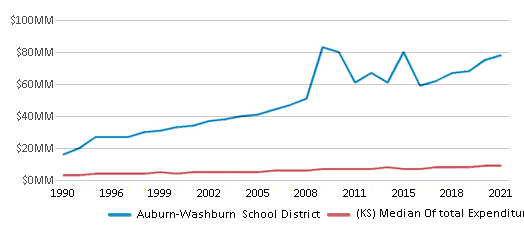
Revenue / Student
$13,669
$16,276
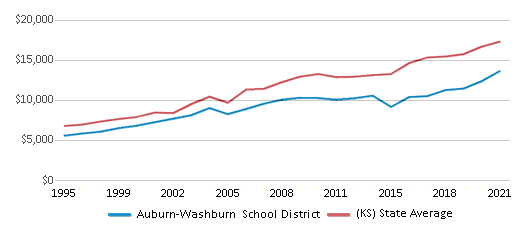
Spending / Student
$12,979
$17,192
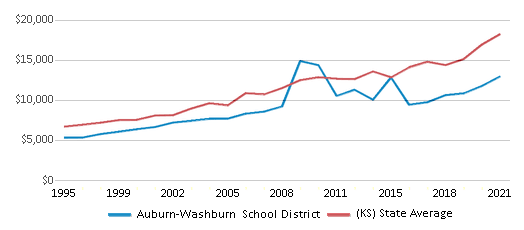
Best Auburn-Washburn School District Public Middle Schools (2025)
School
(Math and Reading Proficiency)
(Math and Reading Proficiency)
Location
Grades
Students
Rank: #11.
Washburn Rural Middle School
(Math: 28% | Reading: 24%)
Rank:
Rank:
4/
Bottom 50%10
5620 Sw 61st
Topeka, KS 66619
(785) 339-4300
Topeka, KS 66619
(785) 339-4300
Grades: 7-8
| 1,008 students
Recent Articles

Year-Round Or Traditional Schedule?
Which is more appropriate for your child? A year-round attendance schedule or traditional schedule? We look at the pros and cons.

Why You Should Encourage Your Child to Join a Sports Team
Participating in team sports has a great many benefits for children, there is no doubt. In this article you will learn what those benefits are.

White Students are Now the Minority in U.S. Public Schools
Increasing birth rates among immigrant families from Asia and Central and South America, combined with lower birth rates among white families, means that for the first time in history, public school students in the United States are majority-minority. This shift in demographics poses difficulties for schools as they work to accommodate children of varying language abilities and socio-economic backgrounds.





